
“This place is a maze!” That is the first impression expressed by many when they walk through the broadcast building. Two buildings have been added, with seamless access between them. If you know where to look, you can see remnants of the past.
 Aerial view of WRAL Campus
Aerial view of WRAL Campus
The first building contains studio A and B and was completed in 1957. The 2nd building adjacent to it was built as an auditorium and stage for the A.J. Fletcher Opera Company. The 3rd building, which serves as a news room/set upstairs with offices downstairs, opened for business in 2000. Renovations to the CBC administrative building brought new life to it in 2013.
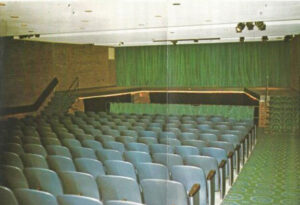 WRAL Auditorium interior
WRAL Auditorium interior
Today, we will primarily concentrate on the area beneath the auditorium stage of building number two. We know it better as the editing suites for WRAL-TV local programming and promotion. Jay Jennings is currently camped out down there, as well as Steve Elizondo and Shan Zhong. But first, we need to know the bigger picture, set the “stage” and then we’ll drill down.
 Hallway slope
Hallway slope
The first visual clue that something is very different is the downward slope of the hallway that leads down to the video vault and then steps up to Steve and Shan’s area. That slope mirrors the slope and seating of the auditorium. Some WRAL employees remember when staff meetings were held in that large space, others remember sneaking in for a quick nap in the dark.
So, what happened to the auditorium? In 1980, WRAL News Director Steve Grissom, eyed it as the perfect location to relocate the news department. At that time, news was located in cramped quarters now occupied by Engineering on the top floor of the building. (This is starting to feel like a shell game.) Steve was gearing up to produce an hour long newscast which required more staff, resources and a much larger space. Hammering and sawing started and the transformation was underway by late 1980.
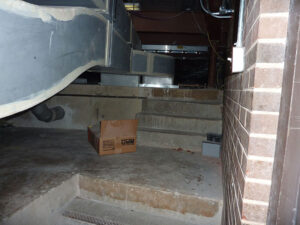 Steps on the right lead to orchestra pit on the left.
Steps on the right lead to orchestra pit on the left.
The elevation of the stage became the reference point for a new floor. The new floor covered over the aisles and seating area. With the raised floor, everything would be level from the stage all the way to the front wall of the building. Remnants of the old auditorium are still visible underneath the covered area. The steps seen in this picture led down to the orchestra pit, in front of the stage. I wonder if we listened hard enough – would we hear the orchestra playing the opera “Marriage of Figaro” by Mozart?
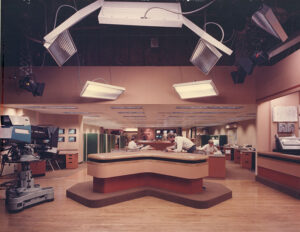 Open concept newsroom , WRAL-TV circa 1982.
Open concept newsroom , WRAL-TV circa 1982.
The stage was transformed in the news set. The open concept newsroom allowed viewers to see reporters busy in the background. Other hints of the auditorium could be seen in the newsroom.
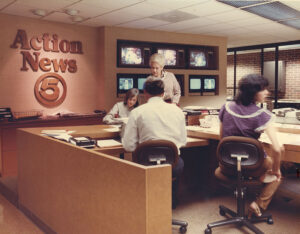 The brick wall can be seen in the teletype/copier room on the right .
The brick wall can be seen in the teletype/copier room on the right .
Sections of the brick wall of the old auditorium were left visible in the newsroom. A tiny part of the wooden stage can be found in a storage area used by production.
Today, that entire area is the current location of the mini-studio/control rooms and Master Control for WRAL and WRAZ.
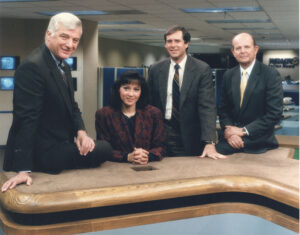 Charlie Gaddy, Adele Arakawa, Tom Suiter, Bob Debardelaben on set.
Charlie Gaddy, Adele Arakawa, Tom Suiter, Bob Debardelaben on set.
The current location of Control Room 2, crew chief office, and mini Studio F/Control Room 5 is the approximate location where Charlie Gaddy, Adele Arakawa, Bob Debardelaben and Tommy Suiter would have been seated at the anchor desk. The current Master Control area is where the assignment desk, News Director’s office, and small conference room would have been located.
 The stairwell leading down to area beneath the stage.
The stairwell leading down to area beneath the stage.
Now, about that staircase that is behind control room 2…where does that lead us? That area has more lives than you can shake a stick at! As a reminder, it is currently the home for Steve Elizondo, Shan Zhong, Jay Jennings, and edit suites for WRAL local programming and creative services.
The area under the stage was accessed by the stairwell behind the wall. The steps are slightly wider than the original staircase for compliance reasons. That space was the original location of the print shop/mail room maintained by Carl Horton. To make room for the Satellite News Channel (SNC) the mail room was relocated near prop storage. In early 1982, the news staff moved into their new quarters and the newscast moved from Studio B to the open newsroom/set. The hour long newscast premiered on June 14, 1982 and two weeks later SNC premiered.
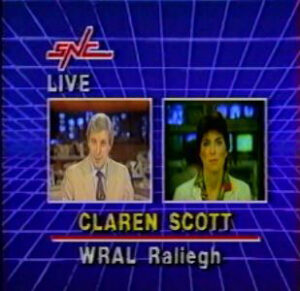 WRAL’s Claren Scott live on SNC.
WRAL’s Claren Scott live on SNC.
SNC was a joint venture of the American Broadcasting Company (ABC) and Westinghouse Broadcasting (Group W). WRAL provided local and regional news during the 10 minute cut-in allotted every half-hour to local cable providers. The small glass enclosed control room was situated behind the news anchor, which created the illusion of a major news gathering center! So, news was presented on stage and beneath the stage, sometimes at the same time! In October 1983, SNC closed down. But that little area would live another life.
Two months later, Steve Grissom, now heading up C2S2 (Capitol Communications and Satellite Company) not only pressed the old uplinks/downlink satellite dishes used for SNC into use, he continued to repurpose the section beneath the stage. Hammering, sawing, drilling converted part of the SNC space into the satellite control center for C2S2, while the rest of the area was dedicated to the new WeatherCenter Channel for cable television. By January 1984, everything was up and running.
The area had stable tenants from 1983 – 1993. The WeatherCenter and C2S2 housed the technical aspects of their operation in that area.
Jay Jennings, WRAL Documentary Photographer recalls that he and documentary producer Chris Albro moved into the old glass enclosed SNC control room sometime during the latter part of 1993. Jay also said they eventually moved their operation to in front of the glass sometime before 1995, but can’t recall the reason for the slight move. The WeatherCenter still occupied the other half of the room. Jay recalls many happy days with Greg and the other meteorologists during that time.
In 1995, the WeatherCenter moved out from under the stage/news set for higher ground where Chris Cole currently has his office near the prop storage area. The documentary staff would soon move into the old PM Magazine office – two doors down from the video vault. There was a new tenant coming, a mysterious one.
Jay Jennings remembers when the late Al Dunbar, Chief Engineer, and a couple of engineers “showed up and whipped out their tape measures. Something was up, but Al wasn’t talking. However, news – especially secret news, travels fast; WRAZ WB50 was about to become the new tenant.” It would become the location for WRAZ’s Master Control.
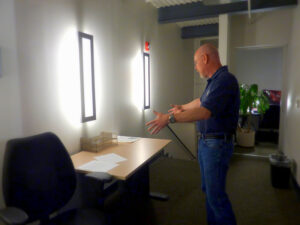 WRAZ’s Scott Reid remembers exactly where his office was beneath the stage.
WRAZ’s Scott Reid remembers exactly where his office was beneath the stage.
WRAZ’s, Scott Reid recalls the no frills, utilitarian space. “Even when WRAZ went on air in ‘95, the basement was not complete. The late Luther Ritchie was building master control in the basement. We went downstairs about a month later. I was editing on a folding table in Studio A (it was not ideal when Spiritual Awakening was taping; very loud). When we moved to the basement there were two small offices and a wall of racks, I’d guess ten that housed many SVHS tape decks, and the satellite tuners. One of the offices was for Luther. The station wanted him to be close to Master Control since we were using a digital tapeless system for air – Allimar. The other housed three racks of editing equipment-which is where I worked with JG Smith. Both offices were maybe six feet by six feet. In August of 1998, we moved to Durham. I returned to the building sometime in late September of ‘98, and went downstairs to look at the former WRAZ area. I found a master control traffic log on the floor in a pile of garbage – I believe it to be one from the first day of operation of WRAZ. John has the log now, complete with the initials of the original WRAZ MC operators.”
 WRAZ’s Scott Reid shows the water level in the hallway after Hurricane Fran.
WRAZ’s Scott Reid shows the water level in the hallway after Hurricane Fran.
Scott also remembers when Hurricane Fran wrought her fury on Raleigh in 1996. Torrential rain pounded the area. Water made its way into the building and rushed down the hallway with the severe slope, and pooled down in the area where the video-vault is located.
In 1998, WRAZ moved to Durham. WRAL Engineering swooped in and made claim to the space for their maintenance area until they moved to “The Dust Bowl,”AKA the former PM Magazine office located down the hallway in 2008.
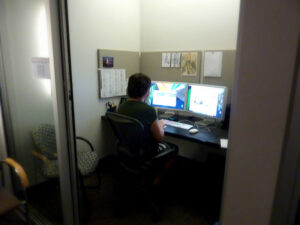 WRAL’s Anita Normanly editing a commercial in the “Hive.”
WRAL’s Anita Normanly editing a commercial in the “Hive.”
In 2008, the space was converted into editing suites for WRAL local production and creative services. In late September/early October 2010 the editing suites buzzed with activity and became known as “The Hive.” The worker bees who inhabit the hive hosted an open house around Christmas time, complete with sugar coated cookies, pastries, and no doubt…a little honey.
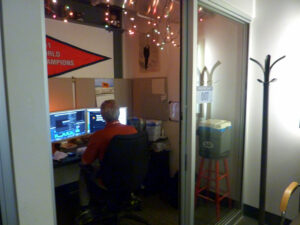 WRAL’s Jay Jennings working on a documentary.
WRAL’s Jay Jennings working on a documentary.
Creativity permeates every corner of the CBC campus. In this historic space located under the AJ Fletcher Auditorium stage, award winning promos, documentaries, commercials, animation are created and edited in a place that has historic significance to Capitol Broadcasting Company. I wonder where they will move next?
Special thanks to Pete Sockett, Tony Gupton, Mike Upchurch, Steve Elizondo, and Jay Jennings.
Thanks to Corp’s Pam Allen for this capcom story. Pam Parris Allen is a former WRAL newscast producer/director who now works as a researcher and producer on the CBC History Project.